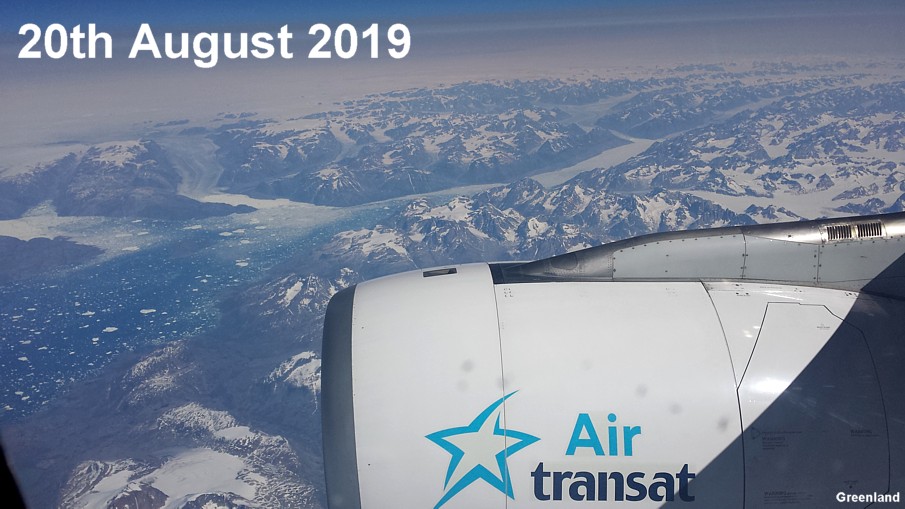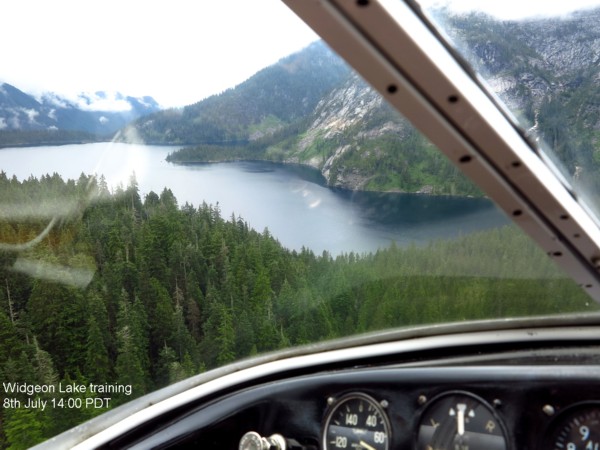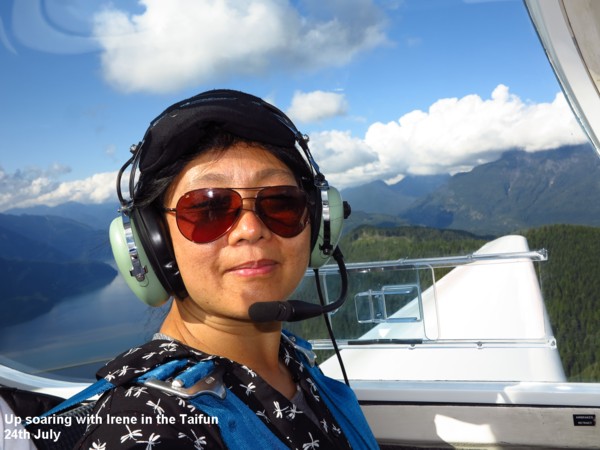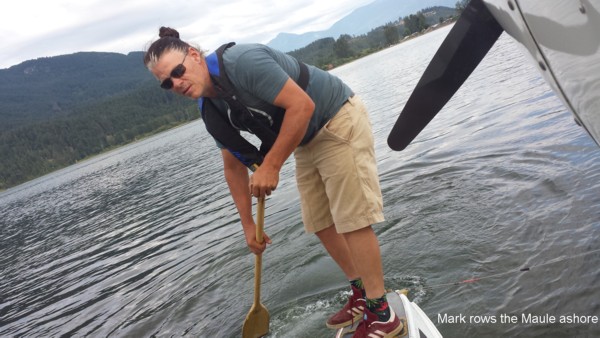
Back to British Columbia

Back to British Columbia

Off on my travels again
British Columbia
I fly and I need to make my
living.
Recently there have been many reminders of the passage of time as
'recent' memories are in fact years old!
I look at life in sections, times for each element of life,
growing up, formal education, career, relationship, (family),
life, retirement, old age, death, but this life is not a standard
life.
Many things in a standard life line have been missed, passed
over, and the result is I am not tied down while not having much
in resources, no home of my own, no family, and some regrets.
Best not to rue the things missed, and missing, simply get on
with what I do.
I love England, I'm at home in Chiang Mai, and while British Columbia annoys me immensely on the ground, it is a superb place to do what I do, fly.
I had two projects booked
in Canada, the first being to complete Sam's seaplane rating, and
the second was to go and look at a motor glider and if it was
alright help ferry it back to Boundary Bay from St Hubert. Enough
to cover the cost of the air ticket, and putting me in a position
to earn a little more money too.
CAA/EASA does not recognise the FAA and Canadian Commercial Pilot
knowledge as being ICAO compliant and so I would have to do their
exams at a cost of time and money as well as dual training and
ground school to do what I already do in Canada, and have done in
China and Thailand. I look at my life line and consider whether
it's worth the bother expending on the CAA/EASA instructor
rating, or whether I should simply go to Vancouver for months of
the year and do what I do there. I think the commuting back and
forth route is a good idea.
My services are required in Canada, but not enough to afford to
live in the Vancouver area for long... Besides, if I concentrate
my times in BC, I can compress the flying work available into a
time where the income can exceed the expenses comfortably.
The situation is that there is only so much work, and spread over
a year this is insufficient for the cost of living expense. Then
there's the dreaded winter months of being largely grounded, I'd
rather be grounded in England, and am more than comfortable being
grounded in Chiang Mai.
Air Transat TS495 departed
London Gatwick direct to Vancouver on the 5th July, on schedule.
Volmer Sportsman C GHJO departed Boundary Bay Airport at 13:44
6th July for Stave Lake, Alouette Lake, and Pitt Meadows, not on
any particular schedule.

There was some damage to
the fabric on the base of the rudder of the Volmer and so I
employed my fabric skills again on this aeroplane. It was only
minor damage, a small split in the base of the rudder, but one
must protect the structure from water injestion.
Flying these sorts of aircraft does require more than simple
flying skills, they demand technical skills too.

Sam already had a few hours
seaplane training and so all we needed to do was to finish up.
There was a lot of flotsum in the Fraser River and so we carried
on to Stave Lake where we did five splashes. Here we compared
angles of view to see objects in the water. You need to consider
the angle at which you look at the surface of the water to see
both objects on and below the surface. Too shallow and angle and
you might not spot the log among the waves, and will not see
what's just below the surface.
Three more splashes were done in Alouette Lake, engine failures
on the takeoff run ("slide"), and engine failure after
takeoff (EFATO). We step taxied and turned on the water, motor
boating the flying boat.
Water conditions can change
from moment to moment.
After fueling at Pitt Meadows we took off to do some more water
work on Pitt Lake with four splashes, and manoeuvring on the
water.
Over on Alouette Lake the water conditions had turned rough, so a
useful bit of training was done there before continuing to Fort
Langley where we did a splash and go in the Fraser River.
There's an area that is usually fairly clear of the flotsum most
of which takes the main course of the river.
The Canadian Seaplane Rating requires a solo with at least five
splashes with the student being the sole occupant of the
aeroplane.
Sam took off from Fort Langley's runway, put the wheels up, and
completed his alightings on the river.

On the step.

Drip trail.
Licence to Learn

The seaplane rating allows
you to fly with passengers, but it is also a 'licence to learn'
and so you must build your experience carefully.
One interesting exercise is flying into confined lakes, higher
level lakes, and glassy water lakes with limited run available.
Widgeon Lake is an excellent place in which to practice.
So though all the seaplane requirements had been met, Sam and I
flew to Widgeon to rock the aeroplane off the glassy surface, to
do takeoffs from a step turn, approaches from the steep mountain
side, and over the lower outfall water fall.
Steep approaches are 'easy' in this aeroplane which descends as
fast as many a rock face, with an intermediate angular change
advisable to make the flare to the alighting attitude less
dramatic.

After Widgeon we dropped into Pitt Meadows where Christine at Island Coastal very kindly signed off Sam's Seaplane Rating


In the afternoon I took two people for a
quick flight to the Golden Ears which were unfortunately shrouded
in cloud, and then to Vancouver City
The next day, 9th July I was once again on Air Transat, this time flying to Montreal. I have written a separate report on the Montreal flight, www.mpaviation.com/volks.htm
Back from Montreal

24th July, first task was to fly Daryl's
friend Irene in the Valentin Taifun 17E, soaring next to Pitt
Lake

At Boundary Bay the ideal
place to park the Taifun was on Apron 3 which is infested with
enthusiasts who love aeroplanes and are always ready to help each
other.
There are two entries to Apron 3, via taxiway Hotel at the end of
runway 31/13, and Foxtrot by the threshold of runway 25.
In the Canada Flight Supplement taxiway Foxtrot is limited to
aeroplanes of 50 foot span or less. I believe this was due to
work being done in its vicinity a while ago, and so I went out
with one of Alpha's ground staff to measure it. There were no
obstacles within range of the Taifun's wingspan, nothing at all.
Discussion with the airport manager lead nowhere, rules are
rules, and he was unwilling to do anything about this restriction
citing safety as well. There was nothing unsafe.
So to be based at Boundary Bay the aeroplane would have to be in
the expensive transient park, and be charged for two spaces, this
lead to an unsurprising expensive bill by the time we moved the
aeroplane. I was very disappointed.

The Limbach VW engine only takes 2.5 litres
of oil, it's a very smooth running engine too
After the oil change Daryl
and I went flying in the Taifun... On entry I noticed the
altimeter was exactly one hundred feet out compared to the
altimeter setting on the ATIS (30.23"hg), and zeroed at
30.33"hg (CZBB is at sea level). I thought they had the ATIS
wrong and so I listened to Vancouver Airport's ATIS which was
also 30.23", interesting... I set the altimeter to zero.
The airspeed indicator behaved oddly after takeoff, under
reading, and fluctuating. Attitude and power, I took control and
flew us around one circuit and landed. Taxied to Canada West
Avionics and left the aeroplane there for them to investigate the
pitot static system.

I take my responsibilities very seriously, and so went to
exercise the Chipmunk with my brother Gary
"Just a quick barrel..." - "A loop, don't worry I
will be gentle", "You just have to don't you" said
Gary. "Yes"

Esther now has the jet job, flying a CRJ, her first flying job
was as an instructor working for me
Flying continued in the
Taifun with circuits at Boundary Bay then on the 30th July we
departed Boundary Bay to Pitt Meadows... As we flew over Blackie
Spit at 2,000 feet (I prefer 1,900 feet) ATC suddenly came over
the radio with urgency, descend descend you are in controlled
airspace... The radar showed us at 2,600', but the altimeter
showed 2,000 feet which was correct in my estimation.
We descended to 1,500 feet, I turned the navigation app on on my
phone and this confirmed the vicinity of that altitude... Now the
radar read us at 1,000 feet!
Turned back, and took the aeroplane to Canada West Avionics...
The altitude encoder was reading all over the place when they
tested it, and they replaced it with another one that checked out
correct.

31st July, went for an evening flight in the Maule with Mark to Rowena's/Sandpiper Golf Course for dinner



GA8 Airvan troubles
The plan had been to fly
with Min in her father's Airvan, but when we pulled it out of the
hangar fuel sloshed out onto the ground from the belly of the
aeroplane... Another fuel leak!
This aeroplane suffers a lot for its fuel system which uses a
stupid toilet (ball) valve setup to meter the fuel evenly from
the wing tanks. It uses a simple assumption that the aeroplane
will fly one wing low if the low wing's tank has more fuel in it,
in which case the associated toilet valve will open to feed more
fuel from that side. It does not work in flight, it will work
stable on the ground, and it's a bloody stupid idea!
When we brought the aeroplane back from the aeroplane used a
worrying amount of fuel from the left tank. I was offended to be
accused of not keeping the ball in the middle!
The header tank lid was removed and the toilet valves were found
to be badly adjusted, prefering the left tank, they were reset,
and now the system prefers the right tank... Can't win!
Later an annual was done following a few months sitting in the
hangar... The whole contents of the left tank disappeared during
this time, emptying into the belly, and then into the luggage pan
underneath the fuselage where it evaporated. When the aeroplane
was assembled the fuel pipe connections in the belly had not been
tightened properly!
The new problem I surmised was a leaking header tank and so I
turned the fuel off, and we put the aeroplane back into the
hangar.
Pro Maintenance found two holes in the sealant under the lid of
the header tank, this had leaked into the belly of the aeroplane
and the fuel sloshed out through the drain holes when the
aeroplane was moved. They said the sealant had not been properly
cured under the lid.
The consolation prize for Min was a flight in the Chipmunk, and then the next day we drove to Squamish where I gave her a flying lesson in one of Glacier Air's Cessna 172s. It seems Min has caught the flying bug.

5th August I flew the Taifun to Pitt Meadows with Irene where
this aeroplane is welcome, it's also more convenient in many ways
Rescue mission

A friends aeroplane had struck a taxyway light at Powell River damaging one blade of its propeller, stranding a family and their dog, so I flew the Piper Warrior solo up the coast to bring them back.

Training continued in the Taifun at Pitt Meadows.
The aeroplane is slow in the circuit, testing ATC a bit
I don't like to do a lot of circuits in this type of aeroplane,
it's not what it is intended to do

I flew with my Vancouver landlord in the Warrior with his friend up for her first flight in a small aeroplane. We flew between the Golden Ears, and then over Widgeon Lake. 'Did some steep turns and stalls, and five landings to complete a recurrency flight.


The objective was to do some crosswind practice, and we managed
this on the last landing, on 07.
The Volmer has to be crabbed and straightened in a cross wind,
side slip and you'll strike a tip float.